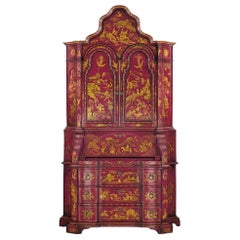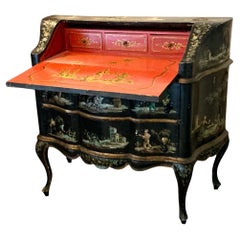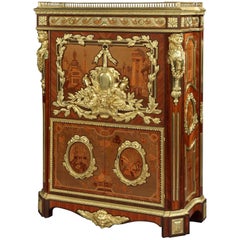Alfonso Marina Secretaires
to
Height
to
Width
to
Depth
to
1
2
2
2
1
1
1
1
2
2
2
Hand Painted Italian Secretaire Inspired by XVIII Century Chinoiserie Furniture
By Alfonso Marina
Located in Bosques de las Lomas, MX
Exquisite Italian Chinoiserie Painted Secretaire, inspired in XVIII Century Italian Secretaire. This piece is hand painted chinoiserie with landscape and scenery on front and sides. ...
Category
21st Century and Contemporary Mexican Cabinets
Materials
Wood
Indo-Portuguese and Mexico Colonial Influenced Poblano Secretaire
By Alfonso Marina
Located in Bosques de las Lomas, MX
The Poblano secretaire has Indo-Portuguese, as well as colonial Mexican influences. The piece is adapted to fit the modern needs of home spaces while conserving its original essence....
Category
21st Century and Contemporary Mexican Cabinets
Materials
Brass
Related Items
Mid-Century Italian Venetian Hand Painted Chinoiserie Secretary Desk
Located in Kennesaw, GA
This is a beautiful piece. This is a lovely mid-century Italian chinoiserie secretary desk. The coral and gilt interior makes such a vibrant statement. Each panel of the serpentine f...
Category
Mid-20th Century Italian Chinoiserie Secretaires
Materials
Poplar
$3,895
H 37.75 in W 40.5 in D 20 in
Rare French Marquetry and Gilt Bronze Secretaire with Architecture Scenes
Located in London, GB
A Truly Magnificent 19th century Secre´taire a` Abattant by Maison Rogie´ of Paris After the original in the Wallace Collection, London, made in 1777 by Pierre-Antoine Foullet
Con...
Category
Antique 19th Century French Louis XV Secretaires
Materials
Carrara Marble, Bronze
$617,446
H 60 in W 43.5 in D 18 in
Art Deco Secretaire Cabinet by Jules Deroubaix
By Jules Deroubaix
Located in North York, ON
This Jules Deroubaix display cabinet secretaire is timeless, functional, and effortlessly chic. Made of burl sandalwood, it showcases a drop door paneled wit...
Category
Vintage 1930s French Art Deco Secretaires
Materials
Brass, Chrome
Baroque Cabinet with Secretaire, Germany 1750
Located in Belmont, MA
Add timeless elegance to your home or office with this original Baroque cabinet featuring a built-in secretary desk, crafted in Germany circa 1750. This exquisite piece originates fr...
Category
Antique 1750s German Baroque Cabinets
Materials
Walnut
Biedermeier Secretaire
Located in Pompano Beach, FL
Biedermeier secretaire made of walnut and cherry with fall front writing surface, nine interior drawers, mirrored cubby hole and three exterior drawers. Germany circa 1840.
Category
Antique 19th Century Secretaires
Materials
Cherry, Walnut
Baroque Cabinet with Secretaire, Germany, 1750-1760
Located in Belmont, MA
Outstanding baroque cabinet with fall top secretaire, South Germany, 1750-1760. Beautiful walnut veneer with exquisite figural and landscape marque...
Category
Antique 1750s German Baroque Cabinets
Materials
Elm, Walnut
20th Century French Art Deco Birchwood Secretaire - Vintage Burlwood Cabinet
Located in West Palm Beach, FL
A detailed, vintage Art Deco French secretaire made of hand crafted polished, partly veneered Birchwood and Burlwood, in good condition. The medium sized cabinet...
Category
Early 20th Century French Art Deco Cabinets
Materials
Metal, Chrome
$31,500
H 48 in W 29.5 in D 15 in
Italian Mahogany Secretaire Cabinet, 1950s
Located in Meda, MB
Precious cabinet secretaire produced in Italy in the 1950s,
The whole cabinet is veneered in mahogany with a fine solid wood carving in the center of the two doors representing two b...
Category
Vintage 1950s Italian Mid-Century Modern Cabinets
Materials
Mahogany, Maple
18th Century Baroque Cabinet with Secretaire, Germany, 1760
Located in Belmont, MA
18th century Baroque cabinet with secretaire, Germany, 1760, walnut veneer. Beautiful piece in excellent condition, professionally rest...
Category
Antique 1760s German Baroque Cabinets
Materials
Walnut
$17,600 Sale Price
20% Off
H 85.83 in W 40.16 in D 21.66 in
British Colonial Secretary
Located in Stamford, CT
A British Colonial secretary, probably Anglo-Indian, in Campaign form with burl wood and ebony and bone inlay.
Category
Antique 19th Century Secretaires
Materials
Bone, Ebony
Spanish Late 18th Century Pine Secretaire with Slanted Desk and Geometric Panels
Located in Atlanta, GA
A Spanish pine tall secretaire from the late 18th century, with carved date, slanted desk and geometric panels. Created in Spain during the last quarte...
Category
Antique Late 18th Century Spanish Secretaires
Materials
Pine
$7,800
H 86 in W 43.75 in D 21 in
King George I Ambassadorial Secrétaire-Cabinet
Located in New Orleans, LA
This highly important secrétaire-cabinet was crafted for and specially ordered by King George I for the British Ambassador to Russia. From its craftsmanship and materials to its exceptional artistry, it is a work of royal and historic significance that exudes power in each and every detail. The broken pediment at its apex features the simplified royal coat of arms bearing the king’s crown, while the interior is adorned by portraits of the British Royal Family. Placed within the ambassador’s St. Petersburg home, this entirely unique piece of furniture would have been a potent reminder of England's grandeur and political importance.
Relations between England and Russia during this period were at an all-time high. Peter the Great had traveled to England in 1698 as part of his widely known “Grand Embassy” tour, wherein he attempted to gain foreign support against the Ottoman Empire. He spent a period of nearly four months there, meeting with King William III and his court on numerous occasions. Noted academic Arthur MacGregor wrote concerning the impact of the trip, “For two decades following Peter's visit, British influence in Russia reached a peak. It manifested itself in social custom, in craft practice and in ships and naval organization... it reached a significant sector of the population before relations cooled once again and the two nations pulled back from this era of unprecedented cordiality.”
First and foremost, however, it is a reminder of British might and influence. By the reign of King George I, England had come into its own as a world power. Unique in its design, this cabinet is a reflection of the country’s might. It is crafted from the highest-quality solid walnut and burr walnut adorned by gilded lock plates and engraved hinges. The presence of ormolu at its apex and lining the doors was a rarity for this period, and its addition makes manifest the importance of the design.
The outer doors open to reveal multiple interiors, including fifteen separate drawers around a central cupboard; the cupboard doors each bear mezzotint portraits of George I and his father, Ernest Augustus, Elector of Hanover. An etching after the portrait of George I dating to circa 1716 is in London’s Royal Academy. A second, inner pair of doors are adorned by mezzotints of the Prince and Princess of Wales (later Queen Caroline and George II), which are both after portraits by Sir Godfrey Kneller dated 1716 in the Royal Collection. A final portrait is revealed on the very interior of the cabinet, where a mezzotint of Frederick, Anne, Amelia and Caroline, children of the Prince of Wales, resides. An etching (circa 1715-1720) after this portrait can be found in the National Portrait Gallery (London).
Apart from its abundance of royal portraiture, the cabinet features stunning painted decoration, including floral designs as well as clouds, birds and trees in a bucolic motif reminiscent of Eden. Its lower portion is a study in both form and function, featuring a fitted secrétaire-drawer above three additional drawers for storage. The cabinet appears in The Shorter Dictionary of English Furniture by R. Edwards from 1964, a text that is regarded as the bible of British furniture design. Edwards describes it as a “writing cabinet...given by George I to the British Ambassador at the Russian court.”
The cabinet was likely made for the 18th-century German diplomat and writer Friedrich Christian Weber, who represented English interests at the Russian court from 1714 until 1719. Although Weber’s tenure as ambassador was relatively short, while in St. Petersburg, he authored his account entitled Das veraenderte Russland (The Present State of Russia), which was published in three volumes in 1721, 1739 and 1740. It may, however, also have been made for George Douglas, 2nd Earl of Dumbarton, who served as ambassador alongside Weber in 1716. Diplomatic relations ceased between the two countries in 1721.
In 1928, the cabinet appeared for sale at the International Exhibition of Antiques & Works of Art in Olympia. It had previously been in the collection of the Woltner family of Bordeaux, the celebrated vintners who owned the estate Château Laville Haut-Brion and produced wine of the same name. According to the family, Monsieur Woltner was given the cabinet as a gift from an aunt who lived in Russia for many years. After leaving the Woltner collection, the cabinet was acquired by William Berry...
Category
Antique 18th Century English Georgian Secretaires
Materials
Brass



